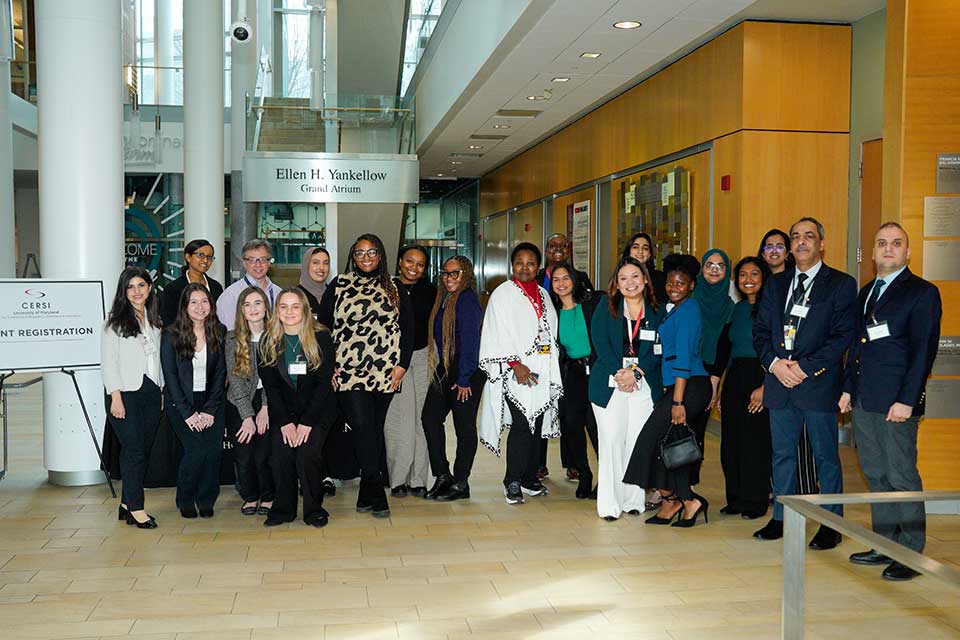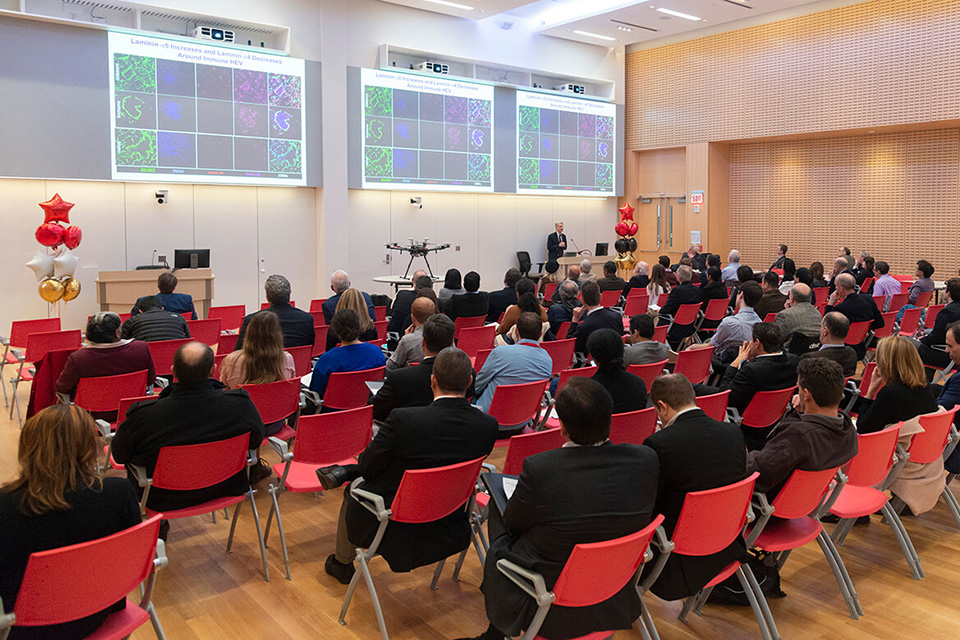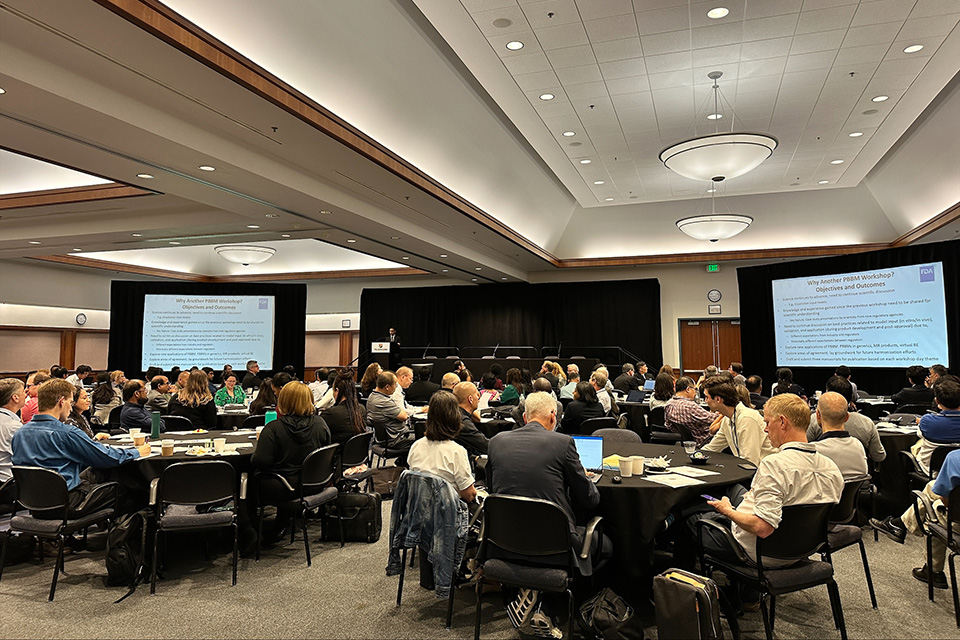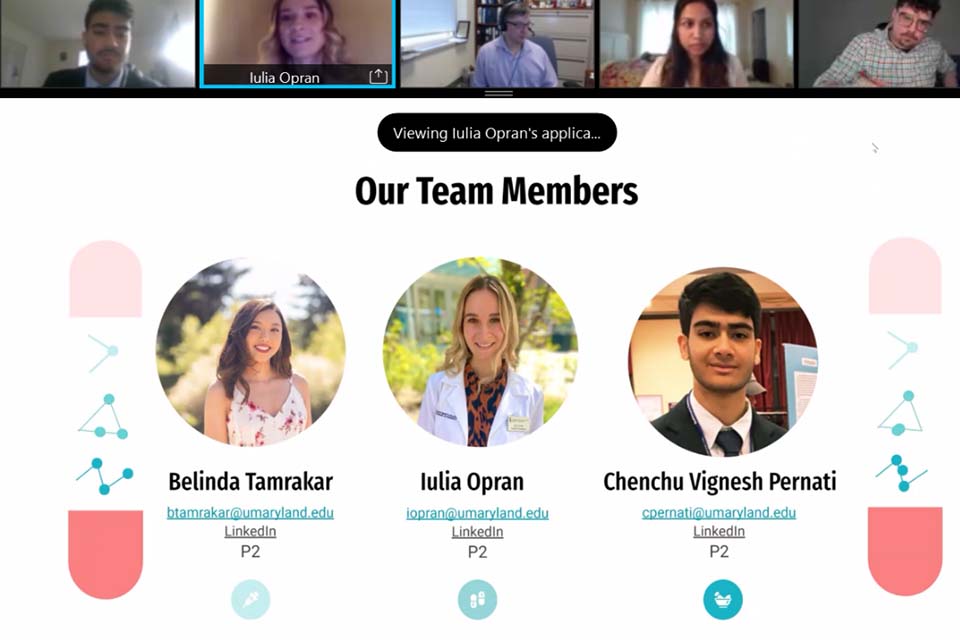Impressive Ideas and Robust Research Showcased at America’s Got Regulatory Science Talent Competition
Six student teams presented issues, findings, and solutions in annual competition focused on promoting interest in regulatory science.

By Pam Carder
February 12, 2025
The University of Maryland Center of Excellence in Regulatory Science and Innovation (M-CERSI), a partnership between the University of Maryland, Baltimore and the University of Maryland, College Park (UMCP), hosted its 13th annual “America’s Got Regulatory Science Talent” Competition on Feb. 3 in Pharmacy Hall.
The competition is open to all students at the University of Maryland, Baltimore and UMCP and aims to promote student interest in the field of regulatory science – the science of developing new tools, standards, and approaches to assess the safety, efficacy, quality, and performance of products regulated by the U.S. Food and Drug Administration (FDA).
“This competition is the academic highlight of the year for me,” says James Polli, PhD, the Shangraw/Noxell Endowed Chair in Industrial Pharmacy and Pharmaceutics at the University of Maryland School of Pharmacy, co-director of M-CERSI, and director of the School of Pharmacy’s MS and Graduate Certificate in Regulatory Science program. “All of the student teams identified needs from different aspects of regulatory science, and proposed feasible solutions to improve outcomes, expedite processes, and utilize available and emerging technologies.”
Six student teams presented their proposed solutions to a panel of judges and answered questions posed by the judges.
The Teams
Team HiddenDose – Rabia Asjid (captain), Sana Bedair, Steve Bedair, Sierra Larson, Gabriella Werking, and Madison Wong
Team HiddenDose proposed a safety app to address adverse events from illicit drug use. By analyzing existing solutions, the team identified gaps in confidential reporting and user support. The app would allow users to report adverse events anonymously, receive personalized counseling, and even identify counterfeit drugs by uploading pictures for instant analysis. It will also provide valuable data to key organizations like the School of Pharmacy’s Maryland Poison Center, while offering easy access to emergency resources and essential links.
The app’s primary goal is to be an anonymous, user-friendly, and judgment-free platform that fosters trust and support. While building this trust is one of the team’s challenges, they acknowledge the app is a supplement, not a replacement, for professional medical care. Additionally, the team recognized the potential for unintended consequences, such as the risk of increasing illicit drug use.
Team AI-Driven Pharmacovigilance – Yassin Ismaeel
Team AI-Driven Pharmacovigilance introduced the idea of an AI-powered app that could help detect adverse events in health care. The proposed app could analyze large amounts of data through AI to catch any potential negative reactions to treatments early on. Data from clinical trials could be one of the key sources of information for the app, giving it real-world insights to help identify even subtle issues.
The presentation offered that by combining nanotechnology and AI, this solution could make a significant difference in patient safety and treatment outcomes. On top of its health care impact, the business potential could be significant, as the app could be used by pharmaceutical companies, integrated into clinical trial processes, and adopted by health care providers.
Team SafeMed – Milka Lenarz
Team SafeMed seeks to tackle a critical challenge in the world of mail-order prescriptions with an app for monitoring product integrity during transit and improving patient safety. Team SafeMed’s research revealed gaps in environmental control, delivery delays, medication loss, and regulation in mail-order prescriptions, all of which pose significant risks to patient safety.
The proposed app would integrate IoT-enabled environmental monitoring to ensure medication safety during transportation. It would include features like real-time location tracking, alerts for temperature deviations, and a patient-friendly, scalable design. The team also presented a clear implementation plan, featuring a pilot program and stakeholder engagement strategies.
Team CycleSync – Haasti Arshadi, Maryam Khalid, Andrea Sequeira, and Luckshikha Uthayathas
Team CycleSync introduced the idea of a wearable patch for menstrual cycle tracking. Unlike existing apps that max out at just 60 percent accuracy, this patch would offer continuous hormone monitoring, providing better reliability. The patch would adhere to the skin and would track key hormones, such as estradiol and cortisol, by inducing and collecting sweat while also detecting temperature through a real-time sensor collaboration. The data collected by the patch would then transfer to an app, where users can view and analyze their results. The app could track fertility and ovulation, offering valuable insights based on the user’s unique goals.
Team Bridge the Gap Trials – Dionne Forbin (captain), Lucrece Chiogo, and Tatiana Egbunine
Team Bridge the Gap Trials addressed the lack of diverse representation in clinical trials, which is essential for accurately assessing the efficacy and safety of drugs across all populations. To address this disparity, the team proposed strategies to enhance recruitment, including expanding efforts beyond academic medical centers. It emphasized the importance of ensuring inclusion in the design phase of studies and advocated for increased regulatory and institutional accountability to guarantee fair representation. Team Bridge the Gap Trials seeks to ensure that clinical research reflects the diversity of the population it aims to serve, leading to more accurate and equitable health care outcomes.
Team Lab Regulators – Grace Mazinga (captain), Rebecca Cherian, Tonia Davidson Maynard, Gertie Mah Dasi, and Sabina Ghale
Team Lab Regulators presented “Adverse Events and Professional Competency: Maintaining the Medical Laboratory Scientist (MLS).” The team highlighted that clinical laboratory tests are responsible for confirming 70 percent of diagnoses in hospital settings, emphasizing the essential role of MLS professionals in patient care. However, with the growing demand for MLSs and a decline in MLS education programs, coupled with a trend toward hiring less specialized personnel, the team warned that diagnostic errors could lead to more adverse events in emergency departments.
To address this challenge, the team advocated for enhanced training and education for MLS professionals, such as more stringent qualifications for MLSs, expanded workforce recruitment efforts, and updated job descriptions to ensure that qualified candidates are hired. By investing in the professional development of MLSs, the team believes the health care system can significantly reduce diagnostic errors and improve patient outcomes.
The Competition Results
Team CycleSync took first place. “This exercise gave me a sense of purpose,” says team member Maryam Khalid, a first-year PharmD student at the School of Pharmacy. “We see this app as a way to empower women, to give them a valuable and useful tool for tracking and controlling what is going on in their own bodies.”
Roberta Glass, MD, senior medical officer at the FDA’s Center for Drug and Evaluation Research (retired), commented on the evident teamwork and shared responsibility within the group and the idea’s ingenuity. “I really enjoyed that Team CycleSync included an image of what the device would look like, and that there would be multiple patch sizes available, which contributes to accessibility,” said Glass.
Team SafeMed was first runner up, and Team HiddenDose was second runner up.
The judges praised Team SafeMed for its thorough presentation, highlighting the clear and detailed research that went into identifying the key elements involved in tracking medications during transit.
Team HiddenDose also garnered recognition for the importance of the issue they addressed. Glass remarked on how each team member contributed a vital piece to the project and recognized the timeliness of their work in addressing drug addiction and developing effective solutions for their target audience.
“All six teams that presented today showcased impressive solutions to the challenges they identified. I commend them for their exceptional research and collaborative efforts,” said Polli.
Individuals who are interested in pursuing a career in the field of regulatory science are encouraged to explore the Master of Science and Graduate Certificate in Regulatory Science programs offered at the School of Pharmacy.



